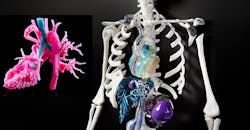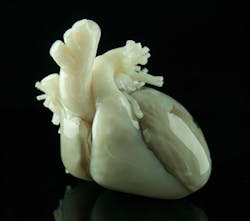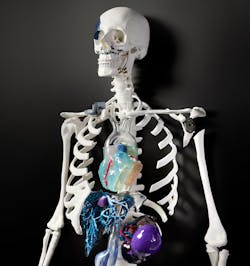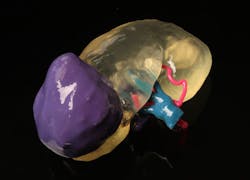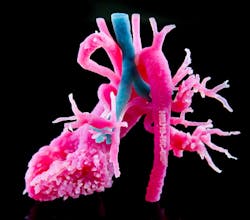3D Printing Gives Rise to External Organs
By taking advantage of 3D printing technology, doctors are presented with tangible, accurate models of organs. This is helping both doctors and students to perform better. Some programs and labs have been started in hospitals to try and adopt 3D printing technology. According to doctors, the program has empowered med students to invent their own solutions to healthcare challenges and helped tighten design cycles. Their products draw from training and experience with actual patients, striving to make a difference in the quality of care for future generations.
The following was derived from an interview from an interview with Todd Pietila, Materialise’s business development manager for hospital 3D printing. He talked about what models are printed, how they help, regulations, and more.
Where 3D-Printed Models are Used
Currently, 3D models are being used in surgical planning, but that is expanding. 3D anatomical models and 3D planning software are used throughout the surgical planning process. This begins with radiologists, who can use the models to more clearly communicate with surgeons, giving them a tangible representation of the defect they will be working to correct in the operating room. They are also able to more clearly explain and demonstrate to patients and families what operations will look like. For surgeons, the variety of printable materials available allows lifelike 3D-printed anatomical models to be used to plan and practice operations. This leads to greater confidence in the operating room.
In addition, it can lead to reduced time in surgery. All of this reduces healthcare costs. By holding a model in the doctor’s hands, they may decide on a better type of surgery or treatment than what was originally planned.
This is a model of a 3D-printed heart.
3D-printed medical models help to increase surgeon confidence in planning procedures and assist in the training of medical students. These tangible reproductions of a patient’s specific anatomy result in more accurate, hands-on planning, and safer procedures for patients with the potential for smaller incisions, less radiation, and less anesthetic.
Research published in The Cleft Palate-Craniofacial Journal has shown this technology can help hospitals save up to 31 minutes in the operating room per case, resulting in cost savings of $1,036 per operation. Implementing 3D printing operations as an in-house service in a hospital can also allow for greater automation, faster turnaround times, and more opportunity for collaboration and iterative work on complex cases.
3D printing can generate implants. This means the implant is generated from the patient’s CT or MRI scan that will provide a custom fit. This eliminates hours of hand-made customization with traditional processes that wouldn’t provide a fit as well as the 3D printed implant.
Types of Models
Drs. Bon Ku and Rob Pugliese of Thomas Jefferson University and Hospital in Philadelphia created a new laboratory with Ultimaker 3D printers for doctors to better hone their skills to perform better under pressure. This program also let students and doctors design tools for their own solutions.
In addition, Stratasys launched BioMimics, which prints accurate models that mimic the material properties of the body. This may someday replace the need for cadavers and allow medical students and doctors to practice as much as they would like before a test or surgery.
There are regulations to consider in the medical field. The Food and Drug Administration (FDA) website explains that it “has established classifications for approximately 1,700 different generic types of devices and grouped them into 16 medical specialties referred to as panels. Each of these generic types of devices is assigned to one of three regulatory classes based on the level of control necessary to assure the safety and effectiveness of the device.”
As a Class II device, this kidney must comply with FDA certification. However, as a model, it will not have the same regulations as an implant that is an example of a class III device.
3D-printed models are not used within the body, but are used to influence treatment of patient diagnostic and practice purposes to help improve pre-operative planning. Since 2017, the software used to develop these models has been classified by the FDA as a Class II medical device. This is the same class of products as orthopedic implants or surgical cutting guides.
Recently, Materialise’s software for designing and 3D printing models has undergone the FDA’s rigorous process of being cleared for diagnostic use. This clearance provides doctors with a stamp of approval that the Materialise Mimics InPrint software and the models it produces are safe and effective. However, there is more to consider than regulations. Knowing the skills needed and nest practices of using 3D printing in this space will be what makes it a success.
Changing the Medical Industry
When adopting 3D printing in a medical setting, it is important to understand the best practices for medical 3D printing processes and quality management, the need for skilled personnel, and the applications and limitations of the wide range of printable materials. Beyond these technical considerations, it is important to understand the types of applications that are best suited for 3D printing solutions to have the greatest value to ensure the 3D printing operation is sustainable in terms of cost.
This three-dimensional model gives the doctor a better understand of what is happening in area of the body they can’t see.
The skills required to properly take advantage of 3D planning and printing in a medical setting include an understanding of volumetric medical imaging, processing of imaging data, digital CAD, design of 3D-printing principles, and how to manage the 3D-printing process.
Understanding all the facets carries with it so much value that companies and organizations are hosting training including Radiological Society of North America and the Society of Manufacturing Engineers. And there is the fast-approaching Materialise Experience, to be held June 7-8 in Detroit.
